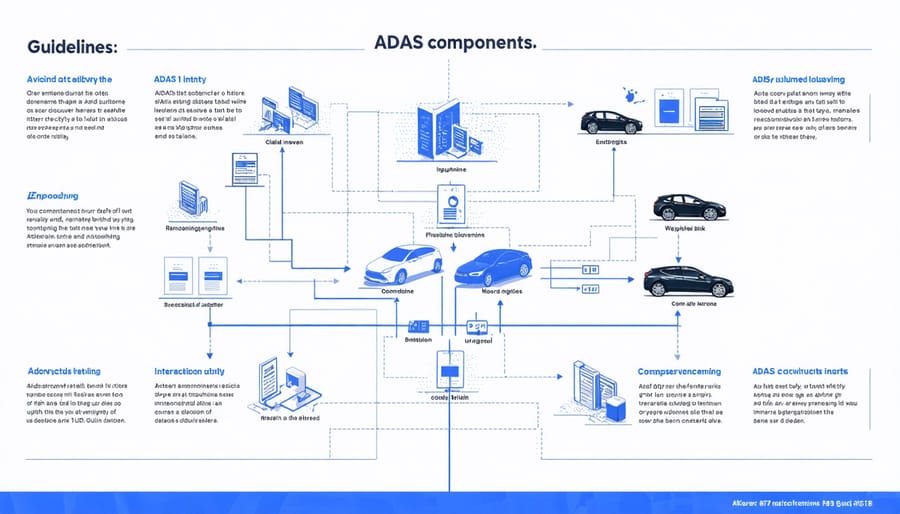The National Highway Traffic Safety Administration (NHTSA) stands at the forefront of revolutionizing how we regulate and implement self-driving technology on American roads. As autonomous vehicles transition from science fiction to reality, NHTSA’s evolving framework of safety standards and testing protocols shapes the future of transportation safety. In 2022 alone, the agency processed over 400 autonomous vehicle incident reports and established groundbreaking guidelines for manufacturers, marking a decisive shift in automotive safety regulation.
This comprehensive oversight addresses both the tremendous potential of autonomous vehicles to reduce the 36,000 annual traffic fatalities in the United States and the complex challenges of ensuring these systems operate safely alongside human drivers. From mandating specific safety features to establishing reporting requirements for autonomous vehicle incidents, NHTSA’s approach balances innovation with public safety, creating a roadmap for the safe deployment of self-driving vehicles across the nation.
The agency’s efforts represent the most significant transformation in automotive safety regulation since the introduction of seatbelt laws, with implications reaching far beyond traditional vehicle safety into the realms of artificial intelligence, cybersecurity, and public trust in autonomous systems.
NHTSA’s Framework for Autonomous Vehicle Safety
Safety Standards and Testing Protocols
The National Highway Traffic Safety Administration (NHTSA) maintains a comprehensive framework for testing and validating autonomous vehicle systems. These standards focus on key safety aspects including sensing capabilities, decision-making algorithms, and emergency response systems.
At the core of NHTSA’s testing protocols are the Automated Vehicle Safety (AVS) principles, which require manufacturers to demonstrate their vehicles can detect and respond to various road conditions, weather situations, and unexpected obstacles. These tests typically involve both controlled environment testing and real-world road trials.
Manufacturers must submit detailed safety assessment reports covering 12 critical areas, including system safety, operational design domain, object detection, fallback conditions, and cybersecurity. Each vehicle must demonstrate reliable performance across these domains before receiving approval for public road testing.
NHTSA’s protocols also emphasize the importance of fail-safe mechanisms. Autonomous vehicles must prove they can safely handle system failures, network disconnections, and sensor malfunctions. This includes immediate transfer of control to a human driver or achieving a minimal risk condition automatically.
The testing process incorporates both physical and virtual simulations. While physical testing evaluates real-world performance, virtual testing allows manufacturers to assess vehicle responses in thousands of scenarios that might be too dangerous or impractical to recreate physically.
Regular updates to these standards ensure they keep pace with advancing technology, with NHTSA continuously refining requirements based on new research and real-world performance data.

Compliance and Reporting Requirements
Manufacturers developing autonomous vehicles must adhere to strict reporting and compliance requirements set by the NHTSA to ensure public safety and transparency. The primary requirement is the submission of safety assessment letters, which detail how companies address 12 critical safety elements, including system safety, testing methods, and cybersecurity measures.
Companies must report any crashes involving their autonomous vehicles within 24 hours of occurrence, providing detailed information about the incident, including weather conditions, speed, and system status at the time of the crash. This data helps the NHTSA identify potential safety issues and trends across different autonomous systems.
Annual reports are mandatory for manufacturers, documenting their testing activities, miles driven, and any disengagements where human intervention was necessary. These reports must include detailed information about software updates, system modifications, and safety improvements implemented throughout the year.
Manufacturers must also maintain comprehensive records of their validation testing, both in simulated environments and real-world conditions. This documentation should demonstrate how their autonomous systems handle various scenarios and weather conditions.
Non-compliance with these requirements can result in significant penalties, including fines up to $21,000 per violation per day. The NHTSA may also issue recall orders for systems that pose safety risks, requiring manufacturers to address defects promptly and notify affected vehicle owners.
AI-Powered Safety Features Under NHTSA Guidelines

Advanced Driver Assistance Systems (ADAS)
Advanced Driver Assistance Systems represent a crucial stepping stone between traditional vehicles and fully AI-powered autonomous vehicles. NHTSA classifies these systems into distinct levels, with most current consumer vehicles featuring Level 1 or Level 2 automation. These systems must comply with strict NHTSA safety standards while enhancing driver safety and comfort.
Common ADAS features include adaptive cruise control, lane departure warnings, automatic emergency braking, and blind-spot monitoring. Each feature undergoes rigorous testing to ensure compliance with NHTSA guidelines. For instance, automatic emergency braking systems must demonstrate reliable detection of obstacles and appropriate response times under various conditions.
NHTSA requires manufacturers to implement fail-safe mechanisms and clear driver alerts when ADAS features are engaged or disengaged. This includes visual, auditory, or haptic feedback to maintain driver awareness. The organization also mandates regular software updates and cybersecurity measures to protect these systems from potential vulnerabilities.
Recent NHTSA regulations have expanded to address emerging technologies like traffic sign recognition and automated parking systems. Manufacturers must provide detailed documentation of their testing procedures and safety validation methods. Additionally, they must report any incidents or malfunctions involving ADAS features to help improve safety standards.
As these systems become more sophisticated, NHTSA continues to adapt its guidelines to ensure public safety while fostering innovation. This includes new requirements for driver monitoring systems and enhanced emergency response capabilities, setting the foundation for future autonomous vehicle development.
Emergency Response Capabilities
The NHTSA’s requirements for autonomous vehicles emphasize robust emergency response capabilities to ensure safety during critical situations. These AI-driven systems must demonstrate the ability to detect and respond to various emergency scenarios, including vehicle malfunctions, accidents, and unexpected road conditions.
One key requirement is the Minimal Risk Condition (MRC) feature, which enables self-driving vehicles to safely pull over and stop when faced with system failures or other emergencies. This includes scenarios where the AI system cannot safely continue operating or when it detects critical hardware malfunctions.
Emergency response protocols also mandate that autonomous vehicles must recognize and appropriately react to emergency vehicles, such as ambulances, fire trucks, and police cars. The AI systems should identify emergency vehicle sirens and lights, then safely yield or pull over as required by law.
NHTSA guidelines specify that autonomous vehicles must maintain reliable communication channels with emergency services. In the event of an accident or system failure, vehicles should automatically alert first responders and provide crucial information about the vehicle’s location and condition.
The requirements also address passenger safety during emergencies. Vehicles must include easily accessible emergency controls that allow passengers to halt autonomous operation and implement emergency protocols. Additionally, autonomous systems should feature redundant safety mechanisms that activate automatically if primary systems fail.
These emergency response capabilities undergo rigorous testing and validation before receiving NHTSA approval. Manufacturers must demonstrate their systems’ reliability through extensive simulation and real-world testing, ensuring their vehicles can handle emergency situations as effectively as human drivers, if not better.
Impact on Manufacturers and Development
Innovation and Compliance Balance
Manufacturers in the autonomous vehicle space face a unique challenge: pushing the boundaries of innovation while strictly adhering to NHTSA’s safety requirements. As autonomous vehicle manufacturing advances, companies must maintain a delicate balance between rapid technological development and regulatory compliance.
This balance often requires manufacturers to implement extensive testing protocols and safety validation processes before deploying new features. For instance, when developing autonomous emergency braking systems, companies must ensure their AI algorithms meet NHTSA’s performance standards while still pushing for improved reaction times and accuracy.
Tesla, Waymo, and other leading manufacturers have adopted an iterative approach, releasing features gradually through pilot programs and limited rollouts. This strategy allows them to gather real-world data while maintaining compliance with safety regulations. They often implement additional safety measures beyond minimum requirements, such as redundant sensors and fail-safe systems.
Manufacturers also engage in regular dialogue with NHTSA through voluntary safety assessments and participation in regulatory workshops. This collaborative approach helps shape realistic guidelines that protect public safety without stifling innovation. As the technology evolves, this partnership between industry and regulators becomes increasingly crucial for ensuring safe deployment of autonomous vehicles while maintaining technological progress.

Future Development Roadmap
The NHTSA’s roadmap for autonomous vehicle development reflects the rapid pace of AI technology advancement and evolving safety requirements. Over the next five years, we can expect significant changes in regulatory frameworks, with a particular focus on standardizing safety validation methods and establishing clear performance benchmarks for self-driving systems.
Key developments on the horizon include the implementation of more sophisticated testing protocols for autonomous emergency braking systems, enhanced requirements for human-machine interfaces, and standardized reporting mechanisms for autonomous vehicle incidents. The NHTSA is also working on developing comprehensive guidelines for cybersecurity measures to protect autonomous vehicles from potential hacking threats.
Looking further ahead, the agency plans to introduce adaptive regulations that can keep pace with technological innovations while maintaining stringent safety standards. This includes the development of virtual testing environments and simulation-based certification processes that will allow manufacturers to validate their autonomous systems more efficiently.
The roadmap also emphasizes increased collaboration between government agencies, automotive manufacturers, and technology companies to create a more unified approach to autonomous vehicle development. This collaborative effort aims to accelerate the safe deployment of self-driving technologies while ensuring consistent safety standards across different jurisdictions and vehicle categories.
Real-World Applications and Consumer Impact
NHTSA’s autonomous vehicle regulations have far-reaching implications for everyday consumers and public safety. As self-driving technology becomes more prevalent, these guidelines shape how we interact with autonomous vehicles in our daily lives.
For consumers, the regulations provide a framework of safety expectations and user rights. When purchasing vehicles with autonomous features, consumers can now rely on standardized safety ratings and clear documentation about the capabilities and limitations of their vehicles. This transparency helps buyers make informed decisions and understand what to expect from their autonomous driving systems.
The public safety impact is particularly notable in urban areas, where autonomous vehicles interact with pedestrians, cyclists, and traditional vehicles. NHTSA’s requirements for emergency response protocols ensure that autonomous vehicles can safely handle unexpected situations, from sudden stops to rerouting around accidents. These safety measures have already shown promising results in reducing collision rates in pilot programs across several cities.
Real-world applications of these regulations can be seen in various scenarios. For example, ride-sharing services implementing autonomous vehicles must now follow specific protocols for passenger safety and vehicle maintenance. Similarly, delivery services using self-driving vehicles must adhere to strict operational guidelines that protect both their service efficiency and public safety.
The regulations also influence how autonomous vehicles handle different weather conditions and road types. Manufacturers must demonstrate their vehicles’ ability to operate safely in rain, snow, and low-visibility conditions before receiving approval. This comprehensive testing requirement directly benefits consumers by ensuring their autonomous vehicles can handle diverse real-world situations.
Looking ahead, these regulations are expected to evolate as technology advances, but their fundamental focus on consumer protection and public safety remains constant. The guidelines continue to shape how autonomous vehicles integrate into our transportation infrastructure, making the transition to self-driving technology smoother and safer for everyone involved.
As autonomous vehicle technology continues to evolve, NHTSA’s role in shaping the future of transportation becomes increasingly critical. The agency’s adaptive approach to regulation, combining safety oversight with innovation-friendly policies, demonstrates its commitment to advancing self-driving technology while protecting public safety.
Looking ahead, we can expect NHTSA to further refine its guidelines as autonomous technology matures. The agency’s focus on data-driven decision-making and collaborative partnerships with manufacturers suggests a promising path forward for the safe deployment of self-driving vehicles. Industry experts anticipate more comprehensive testing protocols, standardized safety metrics, and clearer frameworks for autonomous vehicle classification in the coming years.
The success of autonomous vehicle implementation will largely depend on the continued cooperation between NHTSA, manufacturers, and technology developers. As artificial intelligence and sensor technologies advance, the agency’s regulatory framework will need to evolve accordingly, ensuring that safety standards keep pace with innovation.
For consumers, this means safer roads and more reliable autonomous vehicles in the future. NHTSA’s commitment to transparency and public engagement will help build trust in self-driving technology, while its evidence-based approach to regulation will continue to foster innovation in the automotive industry.
The journey toward fully autonomous vehicles is ongoing, but NHTSA’s balanced approach provides a solid foundation for the safe and successful integration of this transformative technology into our transportation system.

